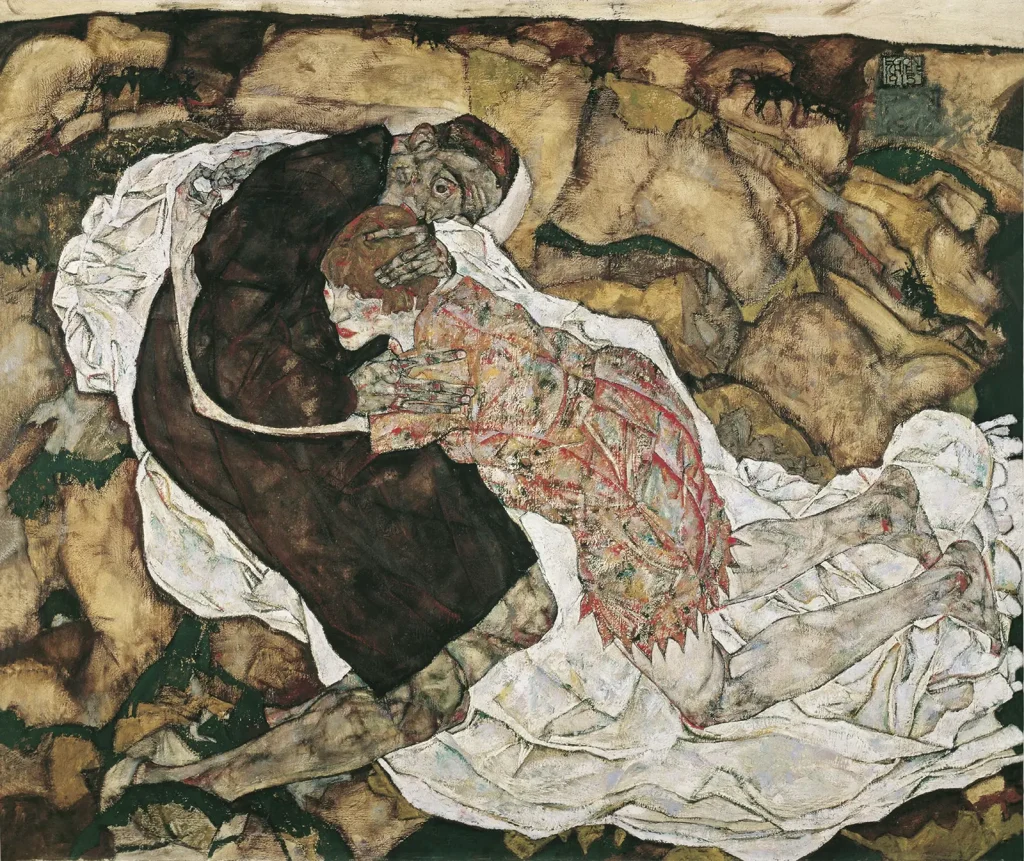Masterpieces of Vienna – Schiele’s Death and the Maiden – In this episode, we explore the depths of Vienna’s cultural heritage, casting a spotlight on one of its most enigmatic treasures: Egon Schiele’s 1915 painting, a profound portrayal of two lovers locked in an intimate embrace. This piece is not just a mere painting; it is a profound expression of Schiele’s inner world, a visual ode to the woman who was his anchor in his darkest times. The artwork is imbued with haunting beauty and emotional depth, vividly capturing the essence of human vulnerability and the complexities of love and betrayal.
This masterful creation stands as a testament to the enduring power of human connection, symbolizing the intense bond Schiele shared with a woman who was his confidante and supporter during his most challenging periods. However, in a dramatic turn of events, she was subsequently cast aside by the artist, a decision that is as enigmatic as the painting itself. The series will delve into this dichotomy, exploring the nuances of Schiele’s personal life, his artistic motivations, and the societal context that influenced his work.
We will explore the intricacies of this relationship and its profound impact on Schiele’s artistry, examining how his personal experiences fueled his creative process and led to the creation of this haunting image. The series will also provide insights into the broader cultural and historical landscape of early 20th-century Vienna, a time of tumultuous change and artistic revolution, which shaped Schiele’s artistic vision.
Join us on this captivating journey through Vienna’s rich artistic history as we unravel the stories behind Schiele’s iconic painting, exploring the emotional depth and historical significance of this remarkable work and its place within the tapestry of Vienna’s cultural artefacts.
Egon Schiele’s “Death and the Maiden”: Vienna’s Artistic Heartbeat
The Soul of Schiele’s 1915 Masterpiece
When you gaze upon Egon Schiele’s “Death and the Maiden”, you’re not just looking at a painting. You’re stepping into a world where each brushstroke tells a story, where every color and line is charged with emotion. This artwork, crafted in 1915, is more than a visual experience; it’s a journey into the depths of human relationships and the complexities of love and loss.
A Glimpse into Schiele’s Artistic World
The Birth of a Visionary
In the bustling artistic corridors of early 20th-century Vienna, a young Egon Schiele was finding his voice. Trained at the Vienna Academy of Art, his early works were influenced by the likes of Gustav Klimt. But Schiele was no mere imitator. He was on a quest to push boundaries, to explore the unspoken and the unseen in human emotions.
The Embrace of Raw Emotion
“Death and the Maiden” is a testament to this journey. In this oil on canvas painting, Schiele doesn’t just depict two figures; he captures an intimate moment frozen in time. The lovers, locked in an embrace, are a blend of turmoil and tranquility. It’s a scene that speaks volumes about the dualities of life and love, about holding on and letting go.
The Heartbeat of “Death and the Maiden”
Love, Loss, and Legacy
At the heart of “Death and the Maiden” lies a poignant story. It’s believed that this painting was Schiele’s tribute to a significant woman in his life, a woman who was both his muse and his torment. This artwork, much like their relationship, is a dance of intimacy and separation, of connection and isolation. Schiele’s own life mirrored these themes, making the painting not just a creation, but a slice of his soul.
A Technique That Speaks
Schiele’s technique in this painting is as haunting as the subject itself. His use of jagged lines and stark contrasts creates a visual tension that’s almost tangible. This isn’t just art; it’s a conversation without words, an exploration of the human condition. The way Schiele plays with color and form brings the painting to life, making it a mirror reflecting our own inner battles.
The Echoes of “Death and the Maiden”
The Painting’s Role in Vienna’s Art Scene
In Vienna, a city known for its rich cultural tapestry, “Death and the Maiden” resonates with a unique frequency. This piece is not just a painting; it’s a cultural landmark. It represents a pivotal moment in the Viennese art scene, a period marked by exploration and expression.
Schiele’s Lasting Influence
A Legacy Beyond Canvas
The influence of “Death and the Maiden” extends far beyond the boundaries of its canvas. Schiele’s work has inspired countless artists, writers, and filmmakers. The painting’s emotional depth continues to captivate audiences, as seen in various documentaries and biopics. It’s a piece that doesn’t just depict a moment; it invites us into a conversation that spans generations.
The Universal Language of Emotion
Schiele’s “Death and the Maiden” speaks a universal language, one of emotion and experience. It’s a painting that transcends time and place, connecting with viewers on a deeply personal level. Each brushstroke, each color, tells a story of love, of loss, and ultimately, of life itself.
Frequently Asked Questions
Q: What makes “Death and the Maiden” unique in Schiele’s body of work?
A: This masterpiece stands out for its raw emotional depth, its bold use of line and color, and its reflection of Schiele’s personal experiences and artistic evolution.
Q: Can “Death and the Maiden” be viewed in person?
A: Yes, the original painting is proudly displayed in the Österreichische Galerie Belvedere in Vienna, inviting admirers from around the world.
Q: How has Schiele’s work influenced modern art?
A: Schiele’s influence is seen in the way modern art embraces raw emotion, explores intimate themes, and breaks conventional boundaries, much like he did with his unique style and approach.
Dive into the world of Egon Schiele’s “Death and the Maiden”, a 1915 masterpiece that captures the essence of Vienna’s art scene and continues to resonate with its profound portrayal of love, loss, and the human experience.




